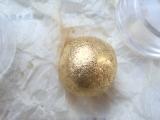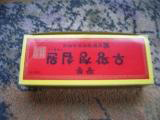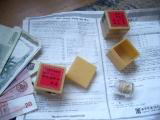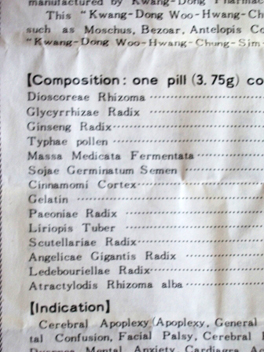Koreaanse traditionele geneeskunde
 In een recent overzichtsartikel, december 2007, vinden we boeiende details hoe men in Korea aspecten van de traditionele geneeskunde een wetenschappelijke basis trachten te geven. Juist in dezelfde maand ontving IOCOB een doosje dat hier afgebeeld staat met daarin 5 gouden pillen, een Koreaanse behandeling van beroerte. Een mooie aanleiding om in te gaan op de Koreaanse traditionele geneeskunde.
In een recent overzichtsartikel, december 2007, vinden we boeiende details hoe men in Korea aspecten van de traditionele geneeskunde een wetenschappelijke basis trachten te geven. Juist in dezelfde maand ontving IOCOB een doosje dat hier afgebeeld staat met daarin 5 gouden pillen, een Koreaanse behandeling van beroerte. Een mooie aanleiding om in te gaan op de Koreaanse traditionele geneeskunde.
De onderzoeker werkte op aan dat project op de Kyung Hee University in Zuid Korea. Daar bestuderen biologen de werkzaamheid van Koreaanse kuiden wat betreft de neuroprotectieve eigenschappen, dat wil zeggen wat ze bij kunnen dragen aan de behandeling van beroertes.
 Daarvoor is een mutidisciplinair team nodig, die de klassieke teksten uit de Koreaanse geneeskunde en herbologie vertalen naar hedendaagse ziekteconcepten, en herkenbare planten. Vervolgens moeten dan die ideeen getest worden in diermodellen.
Daarvoor is een mutidisciplinair team nodig, die de klassieke teksten uit de Koreaanse geneeskunde en herbologie vertalen naar hedendaagse ziekteconcepten, en herkenbare planten. Vervolgens moeten dan die ideeen getest worden in diermodellen.
Politiek en wetenschap: voorbeeld van Tibet
De auteur geeft aan dat er een botsing is geweest en nog is tussen bijvoorbeeld de Tibetaanse geneeskunde, de Chinese interpretatie ervan en de wetenschappelijke onderbouwing. Omdat deze visie voor ons vrij onbekend is, geven we zijn verhaal hier weer:
The situation of power asymmetry and the traditional doctors’ positioning in my study, therefore, require a more complex and nuanced analysis than previous laboratory studies have attempted. In this regard, postcolonial and transcultural studies of Asian medicine provide valuable insights and conceptions about how traditional doctors as subjugated professionals construct their knowledge in interactions with science and biomedicine.
For instance, Vincanne Adams (2001) shows how Tibetan medical practitioners redefine their medicine as science in ambiguous ways in order to resist and accommodate scientific standards, the Chinese state regime and the global market. In the transcultural encounter between biomedical research and Tibetan medicine, Adams (2002) also shows that Tibetan medical practitioners were criminalized because they did not follow the statesanctioned rule of randomized, controlled, double-blind testing.
In a similar vein, Jean Langford (2002) demonstrates how Ayurveda has transformed its knowledge, identity and institutions to respond to biomedicine’s discrimination in that region of India from the time of British colonial rule to the present.
Sean Lei (1999, 2002), Volker Scheid (2002) and Mei Zhan (2001) also scrutinize Chinese doctors’ survival strategies and hybrid formations in interaction with science and biomedicine. These studies of Asian medicine describe uneven power relationships in the making of hybrid medicine, as well as traditional doctors’ inventive combinations of traditional medicine and science/biomedicine. Though the postcolonial space allows Asian medical practitioners to reconstruct their knowledge and institutions, the colonial legacy of science/biomedicine forces its standards and rules on traditional doctors and limits the range and scope of Asian medicine.
Koreaanse geneeskunde
 De Koreaanse geneeskunde is ontstaan ind e 6de eeuw op basis van de Chinese geneeskunde. Vandaar dat ook in Korea naalden en kruiden de basis vormen van de geneeskunde. Tot 1910 was dit de reguliere geneeskunde van Korea. Toen kwam de bezetting van Japan, en alle traditionele Koreaasne geneeskunde werd verboden, men moest westers werken:
De Koreaanse geneeskunde is ontstaan ind e 6de eeuw op basis van de Chinese geneeskunde. Vandaar dat ook in Korea naalden en kruiden de basis vormen van de geneeskunde. Tot 1910 was dit de reguliere geneeskunde van Korea. Toen kwam de bezetting van Japan, en alle traditionele Koreaasne geneeskunde werd verboden, men moest westers werken:
Before Japanese colonization in 1910, KM was the official medicine for the Chosun Dynasty that governed the Korean peninsula for more than 500 years (1392–1910). Prior to Korea’s liberation in 1945, the Japanese colonial regime abolished the KM licence, banned its professional organizations and prohibited the establishment of KM schools. In place of it, the colonial authority implanted biomedicine as the official state medicine.
Pas in 1965 pakte een universiteit weer de traditionele geneeskunde op.
Joong-Poong: Beroerte
Binnen de traditionele Koreaanse geneeskunde wordt Poong gezien als de oorzaak van een beroerte, en daarmee lijkt het erg op de Chinese opvatting van de zogenaamde wind als oorzaak van een plotselinge verlamming. Maar het begrip Joong Poong is eigenlijk veel ruimer, en zou zelfs de ziekte van Parkinson kunnen omvatten. Men heeft gekozen voor het herseninfarct, als focus van verder onderzoek:
The translation of Joong-Poong into cerebral ischaemia does, however, enable researchers to operationalize and organize experimental activities.
Kruiden werden geidentificeerd en er werden verschillende extracten gemaakt, die in cel en dierexperimenten getoetst worden op hun zenuwcelbeschermende werking. Daarbij kwam de focus te liggen bij bepaalde kruiden:
For example, Sukchangpo (Rhizoma acori graminei) is a target herb in the lab because its effect on neuroprotection has been mentioned in a number of classic texts.
Voorbeeld van een Koreaans product: de gouden pil tegen beroerte
De bijsluiter van de Koreaanse gouden pil tegen beroerte, die IOCOB van een patient kreeg, zat in een doosje, waarin en kleinder doosje, waarin de bijsluiter en een nog kleiner doosje. De hele set is op deze pagina afgebeeld. We zien de bestanddelen, er zit in deze pil ook o.a. een dierlijk product, namelijk gemalen hoorn van een antilope. Minder geslaagd, en typisch voor de klassieke Chinese preparaten, die varieren van berenklauw, tot en met vleermuizenkoppen…
We zien de bestanddelen, er zit in deze pil ook o.a. een dierlijk product, namelijk gemalen hoorn van een antilope. Minder geslaagd, en typisch voor de klassieke Chinese preparaten, die varieren van berenklauw, tot en met vleermuizenkoppen…
Resultaten in klassieke en moderne taal
De onderzoekers van Korea waren gewend aan de klassieke teksten en de klassieke teksten, maar daarmee kwamen ze niet weg in de wetenschappelijke literatuur. Dit leidde tot het herformuleren van klassieke bewoordingen naar moderne taal, en de auteur gaf een grappig voorbeeld voor de insiders:
Klassiek
Hwangryunhaedok-tang [CDRT] is a traditional Korean herbal medicine that is formulated with Coptidis rhizoma, Phellodendri Cortex, Scutellariae Radix and Gardeniae fructus. Hwangryunhaedok-tang [CDRT] is cold and bitter in nature and has general properties of clearing Heat and detoxifying, strengthening the stomach and settling the liver, and reducing inflammation, fever and swelling. This formula can prevent and treat artherosclerosis, hyperplasia of the endothelium, cerebral fluid circulation, cerebral vascular deterioration through aging, impairment of neurotransmitters, or disruption of the functioning of the cerebral cortex following infection or trauma. The purpose of the study reported here was to deter-mine the neruoprotective effect of Hwangryunhaedok-tang [CDRT] on global ischemia induced by 4-vessel occlusion in Wistar rats. [italics added: Korean Medicine concepts based upon its theories]
Modern
Based on the use of Scutellaria baicalensis for the treatment of stroke in traditional Oriental medicine, the current study was carried out to evaluate neuroprotective effects of S. baicalensis after transient global ischaemia using rat 4-vessel occlusion model. Methanol extracts from the dried root of S. baicalensis administered intra-peritoneally significantly protected CA 1 neurons against 10 min transient forebrain ischemia as demonstrated by measuring the density of neuronal cells stained with Cresyl violet. Methanol extract of S. baicalensis inhibited microglial tumor necrosis factor-alpha (TNF-α) and nitric oxide production, and protected PC 12 cells from hydrogen peroxide-induced toxicity in vitro.
Publicaties over Koreaanse Planten bij beroerte
Een en ander leidde tot de volgende publicaties:
• Neuroprotective Effect of Gastrodiae rhizoma on Global Ischemia Induced by 4-Vessel Occlusion in Rats (1999) • Neuroprotective Effects of Acori graminei rhizoma on the Brain Ischemia Induced by 4-Vessel Occlusion in Rats (2000) • Cytoprotective Effect of Scutellaria baicalensis in CA1 Hippocampal Neurons of Rats after Global Cerebral Ischemia (2001) • Neuroprotective Effect of Hwangryunhaedok-tang on the Brain Ischemia Induced by 4-Vessel Occlusion in Rats (2002) • Flavonoid Wogonin from Medicinal Herb is Neuroprotective by Inhibiting Inflammatory Activation of Microglia (2003)
Conclusie: clash of paradigms
De auteur eindigde met een verwijzing naar de problemen die er zijn als men klassieke concepten wetenschappelijk wil testen:
Overall, my case study shows the simultaneous possibility and limitation of the scientific translation of KM. KM took advantage of opportunities to enhance its scientific status and to maintain a good relationship with the Korean government as globalization fever swept the nation.
KM expanded its territories by embracing scientists and scientific methods. In doing so, KM defended its scientificity against biomedical professions and infiltrated the periphery of the global neuroscientific field. However, KM has paid dearly to enter the global scientific field.
Without using KM’s own concepts and methodologies, it follows western scientific rules and standards.
Future research on the interaction between local knowledge and global science might benefit from the insight this case study provides on local possibilities within a global hegemony.
Bron
Jongyoung Kim. Construction of Korean Medicine in a Global Age Alternative Medicine’s Encounter with Laboratory Science: The Scientific Construction of Korean Medicine in a Global Age. Social Studies of Science 37/6 (December 2007) 855–880 © SSS and SAGE Publications (Los Angeles, London, New Delhi and Singapore)
Literatuur
Zhan, Mei (2001) ‘Does it Take a Miracle?: Negotiating Knowledges, Identities, and Communities of Traditional Chinese Medicine’, Cultural Anthropology 16(4): 453–80.
Scheid, Volker (2002) Chinese Medicine in Contemporary China: Plurality and Synthesis (Durham, NC: Duke University Press).
Sivin, Nathan (1987) Traditional Medicine in Contemporary China (Ann Arbor, MI: Center for Chinese Studies, University of Michigan).
Lynch, Michael (1988) ‘Sacrifice and the Transformation of the Animal Body into a Scientific Object: Laboratory Culture and Ritual Practice in the Neurosciences’, Social Studies of Science 18: 265–89.
Lei, Sean Hsang-lin (2002) ‘How Did Chinese Medicine Become Experiential?: The Political Epistemology of Jingyan’, Positions 10(2): 333–64.
Lewinsohn, Rachel (1998) ‘Medical Theories, Science, and the Practice of Medicine’, Social Science and Medicine 46(10): 1261–70.
Lynch, Michael (1985) Art and Artifact in Laboratory Science (London: Routledge & Kegan Paul).

